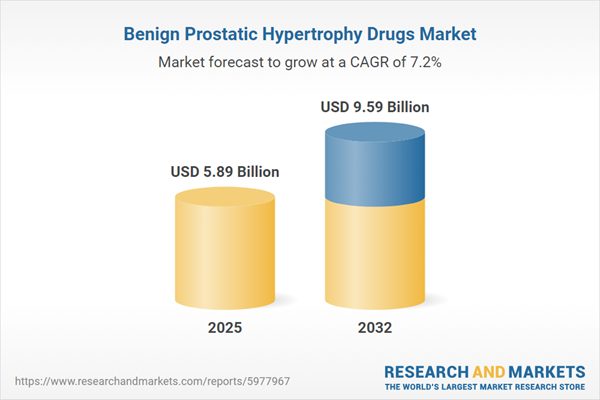Speak directly to the analyst to clarify any post sales queries you may have.
Senior executives navigating the Benign Prostatic Hypertrophy Drugs Market must respond to continued innovation, evolving clinical protocols, and new digital healthcare models. Effective strategies rely on timely insight, agile planning, and clear understanding of shifting patient expectations in this dynamic pharmaceutical sector.
Market Snapshot: Benign Prostatic Hypertrophy Drugs Market
From 2024 to 2025, the Benign Prostatic Hypertrophy Drugs Market is projected to expand from USD 5.50 billion to USD 5.89 billion, reflecting a 7.18% compound annual growth rate. By 2032, the market is anticipated to reach USD 9.59 billion. This robust growth trajectory is fueled by the global aging demographic and a rising incidence of benign prostatic hyperplasia. Pharmaceutical research continually delivers advancements, enabling both established and emerging participants to refine their treatment portfolios. The increasing integration of digital health technologies is accelerating efficiency, supporting the shift towards value-based healthcare, and enhancing patient engagement. Strategic monitoring of regulatory developments and technology adoption is now essential for sustaining a competitive edge.
Scope & Segmentation: Strategic Market Coverage
In-depth market segmentation provides senior leaders with a clear perspective on where to invest, manage risk, and build operational capabilities for the Benign Prostatic Hypertrophy Drugs Market.
- Drug Class: 5-alpha reductase inhibitors such as dutasteride and finasteride, diverse alpha blockers including alfuzosin, doxazosin, silodosin, tamsulosin, and terazosin, as well as advancements in combination therapies. There is also an increasing clinical application of phytotherapeutics, for example, beta-sitosterol, pygeum, and saw palmetto.
- Generic Status: Distinction between branded drugs such as Avodart and Flomax and their generic alternatives is significant. Pricing dynamics, global accessibility, and evolving generic adoption are shaping competitive positions.
- Distribution Channel: Hospital, retail, and online pharmacies offer varied patient access points. Digital and online channels are transforming both geographic reach and patient acquisition strategies.
- Dosage Form: Primary options such as capsules, immediate-release and extended-release tablets, and oral solutions impact patient adherence and define therapy experiences.
- Regional Coverage: Key regions include the Americas, Europe, Middle East and Africa, and Asia-Pacific, each with regulatory nuances and distinct healthcare models. Countries like the US, China, and India are prominent in adopting digital health solutions and driving innovation.
- Key Companies Profiled: Companies such as Merck & Co. Inc., GlaxoSmithKline plc, Teva Pharmaceutical Industries Ltd., Novartis AG, Boehringer Ingelheim International GmbH, Viatris Inc., Sun Pharmaceutical Industries Ltd., Dr. Reddy's Laboratories Ltd., Cipla Limited, and Lupin Limited are highlighted for their market positions and product innovation activities.
Key Takeaways for Senior Executives
- Therapeutic pathways are adapting, emphasizing integrated, patient-centered care across traditional and novel treatment protocols. Continuous innovation is reshaping care pathways to align with real-world needs.
- The adoption of digital health tools such as telemedicine and advanced analytics fosters greater transparency, operational efficiency, and patient engagement within urology-focused care environments.
- Emerging treatment trends, including combination therapies and phytotherapeutics, address diverse healthcare policies and localized market requirements, supporting tailored commercialization strategies.
- Partnerships among pharmaceutical firms, researchers, and service providers streamline regulatory navigation, boost agility, and support efficient time-to-market for new therapies.
- Advancements in drug delivery and formulation address both payer demands for value and patient expectations for convenience, bolstering adherence and uptake across care settings.
- Growth of online and digital pharmacy models extends therapeutic access, particularly benefitting underserved patient populations in regions with emerging healthcare infrastructure.
Tariff Impact
Recent United States tariff changes are influencing procurement preferences within the Benign Prostatic Hypertrophy Drugs Market. Organizations are reassessing domestic versus global sourcing strategies and revising cost-management principles accordingly. Payers and pharmacy networks are updating supply chain structures to ensure ongoing compliance and risk management amid evolving trade policies.
Methodology & Data Sources
This analysis integrates structured inputs from urologists, pharmacologists, and payer organizations; clinical research and regulatory reviews; patent assessments; and proprietary market data. The result is actionable intelligence fully aligned with the priorities of senior decision-makers overseeing pharmaceutical and healthcare operations.
Why This Report Matters
- Enables executives to enhance resource allocation, identify expansion opportunities, and proactively address compliance or operational risks in the Benign Prostatic Hypertrophy Drugs Market.
- Provides practical benchmarking for aligning corporate strategy with evolving technology, regulation, and competitive pressures across global and regional markets.
- Prepares leadership teams to rapidly adapt, strengthen resilience, and seize advantages in an environment of ongoing regulatory and digital health transformation.
Conclusion
Senior leaders equipped with validated, actionable insights can guide organizational priorities and adaptation as the Benign Prostatic Hypertrophy Drugs Market evolves. Strategic flexibility and informed foresight are paramount for sustaining leadership and capitalizing on market changes.
Additional Product Information:
- Purchase of this report includes 1 year online access with quarterly updates.
- This report can be updated on request. Please contact our Customer Experience team using the Ask a Question widget on our website.
Table of Contents
3. Executive Summary
4. Market Overview
7. Cumulative Impact of Artificial Intelligence 2025
Companies Mentioned
The companies profiled in this Benign Prostatic Hypertrophy Drugs market report include:- Merck & Co., Inc.
- GlaxoSmithKline plc
- Teva Pharmaceutical Industries Ltd.
- Novartis AG
- Boehringer Ingelheim International GmbH
- Viatris Inc.
- Sun Pharmaceutical Industries Ltd.
- Dr. Reddy's Laboratories Ltd.
- Cipla Limited
- Lupin Limited
Table Information
| Report Attribute | Details |
|---|---|
| No. of Pages | 195 |
| Published | October 2025 |
| Forecast Period | 2025 - 2032 |
| Estimated Market Value ( USD | $ 5.89 Billion |
| Forecasted Market Value ( USD | $ 9.59 Billion |
| Compound Annual Growth Rate | 7.1% |
| Regions Covered | Global |
| No. of Companies Mentioned | 11 |









